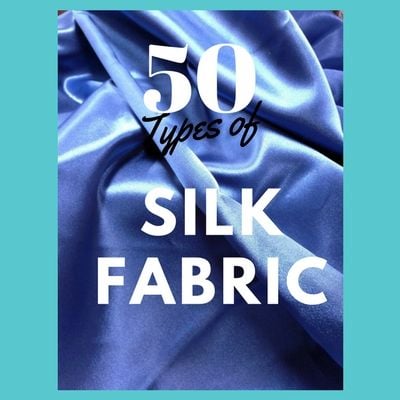
Do you know that it is difficult for even the experts to identify the quality and type of silk? – they need a magnifying glass to inspect the quality of their silk. So you are excused for being confused by all the silk available, as I surely am. When buying fabric to make clothes, I am overwhelmed by all the different types of silk fabrics.
Do you know that it is difficult for even the experts to identify the quality and type of silk? – they need a magnifying glass to inspect the quality of their silk. So you are excused for being confused by all the silk available, as I surely am. When buying fabric to make clothes, I am overwhelmed by all the different types of silk fabrics..
Related post: What is Silk and How is it made.
You have to take into account other silk fabrics made from Spiders and Mussles. In fact, spider silk is said to be one of the best fibers ever discovered. (Checkout this post on Newyorker which says in the future we will all wear spider silk ) Then there are the different species of silkworms other than the renowned Bombyx mori silkworm – all competing to make the best of the best fabrics.
So now you know where the silk comes from and what it is made of, let’s go on to our business – that of making clothes with it; for that, you need silk fabric -yards and yards of beautiful silk.
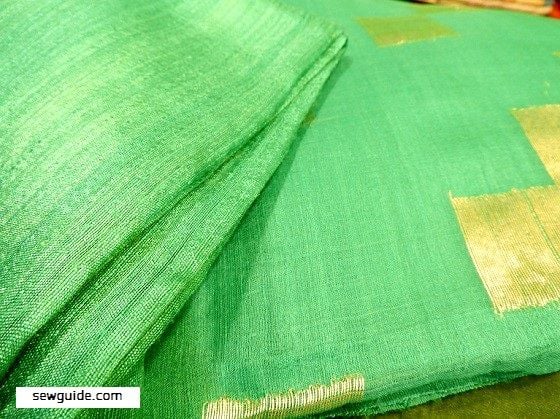
But do you know that not all silk is made equal? Silk is categorized according to many factors – But I am mainly concerned about how the fabric looks and how it drapes and its suitability to make different garments/accessories.
Broadly silk from silkworms is categorized as follows :
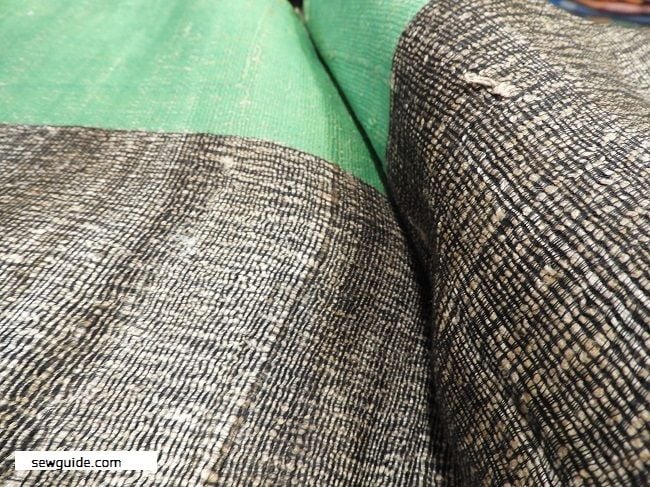
Wild silk (Tusser/Tussore)
This is silk made from wild silkworms that live on oak leaves (oak moth) instead of mulberry leaves. This is coarser in nature and heavier.
The alternate name for this silk is Tussah/ Tusser. There are many types of Tusser silk worms – Indian tusser silkworm Antheraea mylitte Dury, Chinese Tusser silkworm Antherae pernyi Guerin, Japanese tasar silkworm Antheraea yamamai Querin are the different varieties and the silk they produce also vary.
Honan silk is a Chinese vareity of Tussore silk.
Mulberry silk
This Silk is made from fibers given by the domesticated silkworms species knowns as Bombyx mori fed exclusively on Mulberry leaves. Mulberry silk is a general category rather than the name of silk and this category dominates the world silk production by about 80%.
Eri Silk
This is the silk produced from silkworm species called Philosamia ricini, which feeds on castor oil plant leaves. The silk is a white or brick-red variety.
Muga Silk
This is a golden yellow silk produced by strong silk fibers made from the silk worm Antheraea assamensis found in Assam state in India.
Spider silk
Spider silk fibers spun by the spider are said to be as strong or even stronger than steel and very elastic. The commercial and industrial possibilities of spider silk are not yet fully explored.
Sea silk
Sea silk is a silk fabric made from long silky filaments secreted by mussels. This silk fabric is said to be even finer than all other silks and keeps you warm.
Pure silk
Pure silk fabric is made with silk fibers that have been cleaned off the gum but no additives are added to compensate for the weight loss in boiling and cleaning the fibers. It is the purest and finest silk.
Raw Silk
Silk fiber, as it comes from the cocoon, is coated with a protective layer called silk gum, or sericin which is very stiff. Raw silk is a fabric made from this fiber without removing the gum. Read more about different types of raw silk here.
The more specific silk fabrics are as follows
Silk Charmeuse ( Silk Satin)
Silk Charmeuse is a soft, medium-weight silk fabric with a satin-ish and lustrous, glossy face and a dull back (called crepe-backed satin). This is the fabric that comes to your mind as you say silk.
I suppose this is the most preferred fabric for dressmaking because it looks wonderful, is beautifully supple, and drapes well on the figure. With this, you can make lingerie, gowns, loose blouses, scarves, etc.
This fabric is a favorite for making wedding clothes- it is suitably heavy sleek, satiny, and creamy.
Sewing this fabric is not without its challenges, as the fabric is quite slippery, and you have to be extra vigilant when sewing it. It is made with a satin weave, hence the shiny look. Some may not like this satiny look and hence skip this one. It is also slightly clingy. (as per the tips given in this post on dressing tips to make one look thin you had better avoid it if that is what you aim for) . One other problem is charmeuse creases easily.
But all said, silk charmeuse is silk in all its glory. So it is most preferred to make all kinds of garments.
You can also choose a Stretch Silk Charmeuse, which features 5% spandex and gives it stretchiness, sheen, softness, and suppleness. Then there is the Sand washed Charmeuse, which has a toned-down satin surface. Sueded Charmeuse has a light crepe texture.
When sewing and washing take extra care as it snags and puckering of thread is a common problem on the face of the fabric. If you have a silk charmeuse gown which is very much cherished, I would carefully handwash it or dry clean it to be safe.
Chiffon Silk (Crepe chiffon)
Chiffon silk is a soft, sheer fabric with a slightly rough feel (matt, crepe-like feel) because of the use of twisted yarns (in a taffeta weave). Chiffon comes in all colors and prints. It is suitable for making loose flowy clothes. Light to medium-weight silk.
The slippery, flimsy and thin feel of the fabric makes it a difficult material to sew. Checkout some of the tips on the sewing with sheer fabric for how to deal with this problem. Remember that you will need to add a lining when making clothes, unless you want the transparent effect.
Silk Dupioni ( Duppioni or Dupion)
This is a medium-weight, reversible, crisp silk fabric with a nubby texture and loose plain weave. It does not crease/ wrinkle easily and is quite strong (but not very durable).
This fabric is made by weaving two colors of yarns (said to be from two cocoons nested together- considered flawed) and hence has a dull luster and sheen when watched in light – you will find it has different shades. You may see black specs in this fabric- those are part of the fabric and removing them may weaken the fabric.
This fabric is a favorite for sewing clothes, especially as a wedding dress material; it is easier than Charmeuse or chiffon to sew with, as it is more sturdy. The lustrous vivid colors of the dupioni silk and its shimmery look make it a very attractive fabric. You can make beautiful semifitted (tailored) as well as loose-fitting clothes with this fabric.
Prewash dupioni silk before cutting and sewing. Hand wash with extra care (because sometimes the sheen and texture may be lost in washing); usually, it is recommended for dry cleaning.
You can see that most bridal gowns are made in this fabric because of its sheen and the fact that it is inexpensive. You get embossed dupioni silk and embroidered, beaded, and printed dupioni. This fabric does not fray much at the cut edges, but the loose weave may cause seams to unravel—the surface also pills easily. Also, be aware that it has no stretch.
Satin crepe
This fabric has a glossy front face, dull matt, and rough back. It has a nice drape.
Silk Gauze
Silk gauze is a sheer, thin, lightweight open-weave silk fabric with a soft feel and beautiful sheen. It is lighter than chiffon and organza.
This is most often used for sewing as facings, interfacing, or lining. This fabric is not difficult to sew with..
Fuji Silk
Fuji silk is a medium weight and inexpensive silk have a soft luster and great drape. It is used for lining.
Silk Noil
Silk Noil is a low sheen, and slightly bulky silk fabric with a nubby texture (matte surface and rough finish). It is made from the short fibers left after combing and carding, which is why it does not have the shine of other silk fabrics. It is not raw silk.
The short fibers with several knots are used in weaving this fabric – this results in slubs on the surface of the fabric, which results in the nubby texture. They also have subtle specs on them, which are cocoon remnants.
This fabric looks like cotton but is soft like silk and has a good drape, and does not wrinkle easily. It is easy to sew and easy to care for; The cut edges fray easily; This fabric is not as durable as other silks but is in demand because of its easy-to-care nature and wrinkle resistance.
Silk noil is prone to shrinkage in the wash, so prewash. It is hand washable.
Silk Shantung
Silk Hantung is a medium-weight to heavyweight slubbed silk with a crisp feel. Basically, Tussore silk in a taffeta weave. This wild silk is made from silkworms fed on oak tree leaves. It is a very shiny, coarse, but delicate fabric. It is lightweight and airy and does not wrinkle much.
The Indian silk shantung is called Tussah silk.
Silk Organza
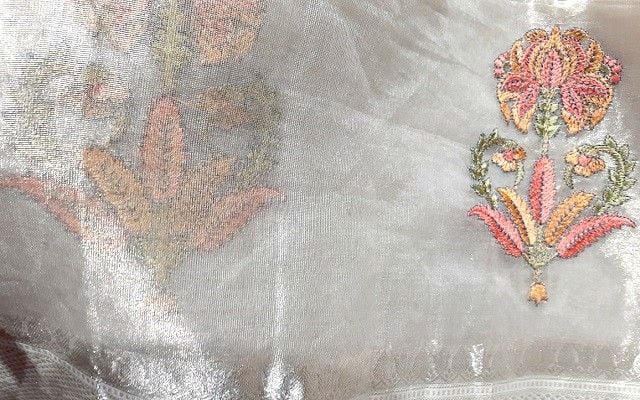
Silk organza is a sheer, crisp, lightweight, strong, and durable silk fabric with a loose weave and smooth texture made of non-degummed plain woven silk. It looks like silk gauze, but silk organza is heavier and stiffer. The fine yarns make this fabric see-through. This fabric creases easily.
It is nowadays mostly used for making linings and for making veils and undergowns. You can also use this to make facings for sheer fabrics. This fabric is also the base for embellished fabrics (embroidered applique pieces, beaded fabrics, etc.).
Silk Broadcloth
Silk Broadcloth is a soft, lightweight silk fabric with a smooth surface and dull luster. Medium-weight silk.
It feels almost like cotton and is easy to sew. It is suitable to make tailored clothes and shirts with the fabric as it holds creases well and has a tight weave, but wrinkles less. It is a delight to make clothes with this fabric.
Silk Brocade
These are silk blend fabric with Jacquard patterns woven on a heavyweight twill/satin base. This is mostly used in home furnishings, for making wedding gowns and costumes and to make jackets. You need lightweight brocade for making clothes. May have rayon fibers added.
Crepe de Chine ( pronounced Krape dee sheen)
Crepe de chine is a lustrous silk fabric (Chinese crepe) with a smooth but slightly matt surface, slippery feel, and great drape. This fabric’s sheen is subtle and heavier than silk habotai fabric.
It is a very comfortable fabric, so used a great deal for dressmaking. Crepe de chine comes in many different varieties like Moroccan crêpe and crêpe georgette.
Silk Crepe
Silk crepe is a lightweight textured silk fabric with a good sheen. Canton Crepe silk is a soft fabric with a fine crinkly surface; it is heavier than Crepe de chine. Crepon is a heavier crepe in silk.
Four-Ply Silk
This is medium to heavyweight silk fabric with a crepe finish and beautiful luster. In fact, this is a heavier version of silk crepe. The heavyweight version of 4 ply silk is the most coveted silk fabric for dress making. The fabric is called 4 ply because 4 individual yarn strands are twisted to make the single yarn of his silk.
This fabric can be hand washed but it is preferable to dry clean it to maintain the sheen and luster.
Silk/metal tissue
Silk/metal tissue is a rather stiff, crinkly and translucent and lustrous gauze made with silk and metalized threads. Very difficult to maintain as it can’t be dry cleaned nor hand washed as it shrinks very much.
Silk Gabardine
This is a dressy smooth twill weave silk fabric with a distinct diagonal line on the fabric. Faintly lustrous, it has a beautiful drape; The fabric resists wrinkles. Durable and crisp, it is most often used for making skirts, slacks, and suits.
Handwash (shrinks more than most), drip dry.
Silk Georgette
Silk georgette is a sheer and strong silk fabric with a dull creped surface and a grainy texture. (Taffeta weave) It is a durable fabric, but when sewing, you have to be very careful as it snags easily. The flowy thin nature of the fabric makes it difficult to sew with. It is also less lustrous and heavier than chiffon and is great for dressmaking.
Silk Taffeta
Taffeta is a plain weave silk fabric with a crisp (even stiff) texture. It has a fine crosswise rib pattern and is reversible. The surface is smooth and finely fluted. It can be soft or stiff according to its make and has a rustle.
Peau de Soie (Duchess Satin)
This is a medium weight smooth, and silky fabric with a satiny, lustrous finish. This fabric looks a lot like silk charmeuse, but Peau de Soie has a moderately stiff drape. This fabric is also very easy to sew with. It is a preferred fabric for making gowns ( also nicknamed bridal satin).
Dry Cleaning is preferred to keep the sheen.
Habutai Silk / Habotai Silk
Habutai is a fine, soft, lustrous, lightweight silk fabric with a great drape. It does not crease /wrinkle easily and sews easily enough. It is also known as Japanese silk because it is from Japan. It is usually used for lining garments and also to make light tops, dresses, and shirts. Very similar to China silk, both are breezy, lightweight, and inexpensive. Also called Parachute silk.
Silk Pongee
This is a silk fabric with a textured surface (raw silk) and has a sheen. This fabric has a soft drape. Pongee silk is very fine and light, even lighter than silk habutai. Usually, the names silk pongee and silk habutai are used interchangeably. It is inexpensive to buy. The fabric is available in many weights. It is a favourite fabric for silk painting.
China Silk
China silk is similar to Habutai in all aspects; other than that, china silk is smoother. It is a somewhat thin silk. You can use it as a lining for gowns rather than making gowns with it.
Twill Silk
This is a thick silk with the diagonal twill lines.
Silk Velvet
A wonderful piled fabric with great drape for making gowns.
Spun silk
This is a silk fabric made with very short fibers; Hence the surface is rough and feels like cotton
Silk Damask / Jaquard silk
This is silk woven with elaborate jacquard patterns. The patterns shimmer in the light when the fabric moves.
Watered silk
This is silk with a design woven into the fabric. The design looks like a watermark on the fabric.
ShotSilk
A silk fabric with an iridescent look because of the use of different colored warp and weft fibers in weaving.
Thai Silk
A tightly woven silk fabric from Thailand. It is a lot like silk shantung but much better.
Japanese Silks
Chirimen Silk
This is a crepe silk with a distinct crimped surface texture. Hitokoshi Chirimen (not as much wrinkles), Futakoshi Chirimen and Kawari Muj are different varieties of this fabric.
Tsumugi Silk
This is a silk with a rough texture like Tussah silk ; but still it is lightweight and soft.
Chichibu-meisen silk.
A double sided iridescent silk with beautiful patterns.
Kinsha silk
A very fine crepe silk
Different types of Indian Silks
India is famous for its silk fabrics and an average Indian woman possesses many silk saris. The following are silk fabrics made in India.
- Silk Matka
Matka is a heavyweight, tightly woven silk handwoven from very thick yarns in India. It has a homespun look. The poor quality Matka silk may have an uneven surface. The fabric, which feels like tweed, is used for making suits and jackets as it holds the shape well; sews easily.
Drycleaning preferred because of possible shrinkage in the wash.
- Tussah
Tussah (also Tussar) silk is a medium to heavyweight loosely woven silk with a rough, uneven surface with distinct crosswise ribs. It is said to be made from wild silkworms and is usually coarser than cultivated silk. Tussah silk is available only in limited colors. This fabric sews easily but may unravel at cut edges. The colors available are limited.
Tussar silk can be hand-washed, but it does shrink; drip dry.
- Surah is a soft, lightweight silk originally made in Surat. This is a very supple fabric with a dull luster.
- Garad Silk – This is a very fine silk with a red border and small paisley motifs.
- Kashemere silk – Soft silk fabric with a twill weave.
- Jamawar – Pashmina silk which contains a blend of cotton and wool.
- Matka Silk – A rough handloom silk fabric made from the waste Mulberry Silk without removing its gum (sericin) part.
- Banarasi/Benarasi Silk – A fine silk evolving with gold and silver brocade and zari work.
- Bangalore Silk – Very pure silk produced in the silk farms of Bangalore.
- Angora Silk– Soft silk made from the fur of Angora rabbit
- Pochampally/Pochampalli Silk – A special type of silk from Pochampally, Indian.
- Mysore Silk – This is silk fabric woven from hard spun silk yarn
- Sournachuri Silk– This silk has gold thread woven along with the silk fibers.
- Kosa Silk- This is a type of lightweight Tussah silk fabric with a soft texture and dull-brownish look.
- Muga Silk– this is a silk made from yellow silk fibers from a special silk worm found in Assam.
- Dharamavaram Silk– This silk fabric has gold plated borders
- Narayanpet Silk – This is a silk fabric with a checked surface design with embroidery and the border or pallu have intricate ethnic designs.
- Pat/Paat Silk– This is a durable and fine silk fabric in white colour.
- Kanchipuram-Beautiful shiny silk fabric made in Kancheepuram.
- Bhagalpuri Silk
- Uppada Silk
- Khadi Silk – This is silk fabric made from handspun silk yarns . Khadi silk is usually 50% cotton and 50% silk. It has a very crisp and neat look and a soft lightweight feel.
- Kora Silk – A silk fabric made from undegummed and untwisted silk fibers. It is usually available in printed form.(Organza silk is also known as Kora silk).
Learn more about Indian silks used in Saris in this post on the different types of saris.
Silk blends
Cotton Silk
Cotton silk is a blend of cotton and silk; It has less sheen than silk and is very inexpensive when compared to silk. It is not slippery like silk and is heavier.
Silk Wool
Silk wool is a blend of wool and silk fibers creates a fabric with most of the fibers’ features, like warmth without the added weight, breathability, moisture absorption, drape, resistance to wrinkles, and suppleness. Silk wool is not as scratchy as pure wool. Silk cashmere, silk merino wool.
Art silk
Art silk is artificial silk made from rayon fibers which look like silk, With the sheen of silk but with less drape and durability. This is a very inexpensive alternative to silk.
Reference :
- www.utsavpedia.com/textiles/silk/
- https://www.scribd.com
- Wikipedia – sea silk
Related posts : A list of best shiny fabrics; How to buy Silk fabric : the important questions to ask ; Washing and caring for silk clothes
Sewing with Silk: 12 FAQ answered
Some Frequently asked questions about different types of silks
Which is a silk fabric with a crisp texture?
Silk Organza is a sheer crisp fabric.
What is fake silk called?
Art silk. Art silk stands for artificial silk. This crisp thin fabric which has a luster similar to silk is usually made of rayon fabric.
Which silk is stretchy?
Silk knit is a very soft, drapey and stretchy fabric. Silk fabrics with small amounts of spandex fibers like a stretch charmeuse silk are also strechy.
Which is the softest silk?
Silk Habotai (Pongee silk, china silk) is a very very soft silk fabric. Silk satin is also very soft. Silk-wool blend fabrics are also very soft.
Which silk has a shiny soft texture on one side and crepe texture on another side?
Silk Charmeuse is also called crepe-back Silk Satin fabric.
Which silks are best for painting?
The most popular fabrics for silk painting are silk habutai, silk charmeuse, and silk wool.
Best silk fabrics for dyeing
Crepe de Chine takes dyes very well. Silk chiffon is also a good fabric for dyeing.

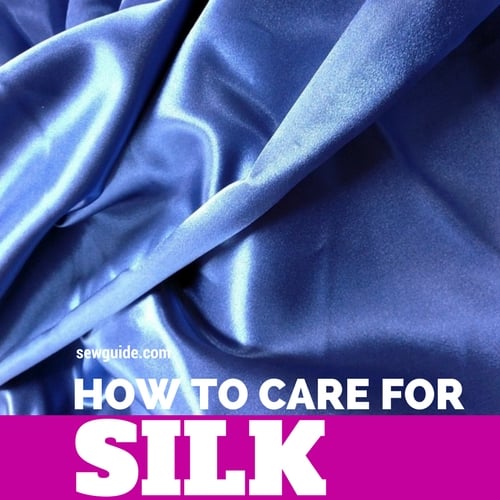
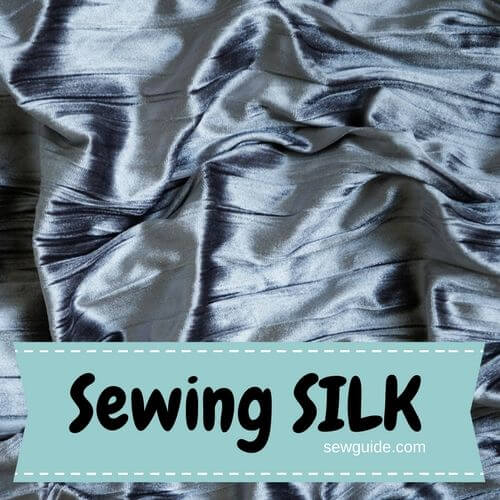
Dear Sir/ Madame,
Greetings from Sri Meenakshmi Silk Coportation
We would like to Introduce Sri Meenakshmi Silk Coportation as a vertical integrated operations from spinning of yarn to manufacturing of clothing. We have all the operations setup in our owned premises in Bangalore.
The Mill established in 1988, today offers form Natural Fibres to Synthetics and Blends. Our fabric range includes wovens/ handlooms/ knits and stretch. A large stock of various base qualities are always kept in stock to dye and print as per requirement.
Our minimums are “No Minimums”. Quality is a Passion and Delivery a Commitment. Creativity is what drives us.
Some of our key products and services—
• Digital Printing
• Dying
• Supply of RFD/ PFP/ Greige Fabrics
• Hand and Machine Embroidery
• Cut and Sew of Garments
• Manufacturing of Scarves/ Pocket Squares.
If you need more information on any of the above please do let us know.
Some of you key strengths in delivery are —
• Eco Friendly Printing and Dying. GOTS Certified. Azzo Free.
• Fabric finishing including Super Soft, Water Repellent and High Fastness.
• No Minimums— Nil Development and Setup Charges. You can ask us for lab-dips and strike-offs.
• Garments— We provide complete pattern construction and technical assistance with grading and fit. High quality engineering sewing is applied.
Some of the other areas we cater to are eco friendly and organic fabrics. Every season our design team comes up with an exclusive selection of fabrics, colours and designs. These are sold on exclusive basis.
We are always happy to do custom developments
Infrastructure includes the best machines from all over the world.
We have sales reps working for us globally and our clientele includes top names in fashion industry. They will be happy to assist you and meet you to talk further.
We look forward to hear from you.
Thank you,
With my best regards,
Rahul Goenka
Sri Meenakshmi Silk Coportation
# 25/1 Shanti Kutir 19th main 7th cross J.P.Nagar 2nd Phase,Bangalore 560062.
INDIA
Mobile -9886381749
Hi! Which silk fabric is good for hand-embroidery? How do we do the waste material backing on the hoop so as not to damage the silk material?
Hi Surekha
Any 100% silk is great for embroidery so long as it has some body to it – if it is thin you can place a cotton fabric as backing and embroider. Dupioni silk, shantung silk etc great for embroidery. China silk is a cheaper material.
I am looking for a silk with:
‘puckered surface’ to make a beadspread – ‘dots’ or a woven pattern.
‘silk wider than 60 “.
washable quilted silk to make a bed spread
Japanese paterned silk wide enough for pillow cases. Obi ?
I need to know names of these weaves.
Thank you very much in advance.
Thank you so much this helped allot
Great info thank you very much. I have been in Cambodia for many years and I came across a silk called ” coral silk ” never heard of this before. Has anyone heard of this or has any info, it would be much appreciated.
The local’s in Cambodia call silk “Hol” which I believe is a general term for all silks.
You can find some local weavers work, which includes the golden Cambodian silk ( raw pure yellow colored silk from the cocoon ) at silk-store-psah.(company.site) .
I’m looking for the renowned but rare golden silk, but I’m a little confused as to what this exactly is. Some say it is the pure raw silk that Silk Store offer, with no dye color added. While other say it isn’t this, it’s the raw silk with golden dye added.
If you have any info about “Cambodian Golden silk” I would be very happy to know about it. Thanks in advance.
One of the best and my favorite blog ever. Aala stuf and best quality.
I like this blog, can I forward it to our website? We are Aily silk, lover of nature too. We want to bring everyone affordable 100% mulberry made fashions and clothings.
What is Rayon Silk Fabric. What does it look like and also give idea about fabric feel and its use.
Hello, Sarina, I have silk to make a dress but I do not have any lining fabric. I read your articles with interest and noted that you said on 6th November 2018 that you do not use silk as a lining. What should I use, please?
Gill
Hi Gillian
Can you read this article on the lining fabrics
What is the best silk to use to make pillow cases, hair scarfs, hair bonnet etc? I presume the silk charmeuse or the silk dupioni?
Hi
I would think – For pillowcases Habotai silk or Silk Charmeuse , Dupioni also but isn’t it expensive ? ; hair scarves – Flat crepe silk, Crepe-de-chine, Silk chiffon, Silk charmuese or Silk Habotai.
Hi,
What type of silk is recommended for outdoor flag use? Thanks.
Hi Maria
I would think outdoor flags are made of Nylon because of their water resistence. Not silk. Silk would get soggy in rain and fade fast in sun.
Extra ordinary
Which silk is kimono silk?
Hi Debbie
I suppose you are asking about the appropriate silk to make Kimonos ? If you want a fabric with a distinct surface texture with crimp you can get what the Japanese use to make Kimonos – Chirimen Silk (crepe silk) or else Habotai Silk is suitable – check out the post on Kimono
Hello Sarina,
Can you advise on the best type of silk to make a headscarf, for warmth and to protect my hair, and something that drapes well.
Thank you
Hi Lin
Silk scarves are usually made in Silk Habotai, Tussah silk (raw silk), Crepe di Chine, silk chiffon. But if you get a silk-wool blend (60/40) that will give you better warmth than silk alone with the softness and drape of silk
A famous book by David Kibbe called ” Metamorphosis” describes a lot of fabrics for different body types. I am a “soft classic” in his book. It mentions I should wear “silky weaves” under the knits and sweater section. Fine knits are good for me as well, but “silky weaves” has me completely stumped for shopping and sewing purposes. How could that fall under the “knits and sweaters” section? What fabrics would that be? Draping is an important factor in this body type which I understand…but I do not know “silky weaves”.. If you give could me specific names of fabrics I will hunt them down!
Hi Betty
I think you mean Satin weave – fabrics like satin, rayon, silk charmeuse, sateen (cotton) have super smooth surface and great drape because of the fabric weave. But knit is knitted – not woven. If you want the smooth surface of the satin weave in knit – slinky knit , smooth cotton jersey are all fine dressmaking fabrics
Hi Sarina! Thanks for the wonderful listing of silks. I searched through them all and couldn’t find the one I’m curious about. It’s called silk knit, but not silk jersey silk knit (that’s been easy to find and so easy to work with!!). It’s this thicker kind of silk that I’ve bought in second hand clothes. Sometimes it’s mixed with cotton, but sometimes it’s 100% silk. Pants can be made of it, dresses, skirts, sweaters, cardigans…It’s similar to silk jersey, but thicker and has less of a sheen. It’s a real knit, like the knit of it is more open than silk jersey. It stretches a bit, too. I’d love to make a jumpsuit out of this material, but don’t know its official name as a silk fabric.
I LOVE spun silk! I have lots of silk spun clothes I’ve collected. One company I’ve gotten some from is Silk Living based out of New Zealand. Also Winter Silks (recently went out of business) sold a lot of silk spun tees and made their long underwear out of spun silk. I haven’t been able to find it as a fabric, otherwise I’d have made some clothing out of it. I just recently bought a Ralph Lauren, calf-length A-line dress made of spun silk. It’s a treasure. Looks and feels like cotton except with a kind of subtle glow not seen in cotton.
I love the casual variety of silks these days, like silk knit, silk jersey, and silk spun that can be made into leggings, shorts, underwear, dresses, t-shirts…It just feels so good to wear. I read that silk has properties in it that protect the skin from electromagnetic energy. Not sure about that one, but it certainly feels like it when wearing. 🙂
A few more links for anybody who would love to have silk spun or silk jersey leggings, t-shirts, dresses, underwear and socks:
www. patra.com
appleseeds. blair.com/catalog/search.jsp?count=9&i=1&intl=n&is=Y&keyword=silk+&page=2&q=silk&rank=rank&store=1 (used to be sold on Winter Silks)
www. silkliving .com/?gclid=CjwKCAjw7O_pBRA3EiwA_lmtfr58brXC_-lh3ZnQss2CGfhhQT5YFzcoan0buJGVbRVnCiKvOlfTUhoCso4QAvD_BwE
www. etsy .com/shop/Mandarinsilk?ref=simple-shop-header-name&listing_id=677485144
Thanks for your input Tanya
Thank you for this detailed information but could you please tell me where I can buy Silk Broadcloth, is it retailed under another name ?
Many thanks.
Hi Margaret
I do not know any other name for it – you may find it in the men’s shirting section of fabric stores as broadcloth is a popular shirt fabric.
Poplin is a similar fabric
Hi, I’m trying to enhance my knowledge in the Silk area as I am about to start my own silky sleepwear brand. I really like this article, very informative, but I could use some help and advise. I want the silk to be one of the finest qualities (etc. Mulbery silk) yet to a reasonable price because I need the cost and income to add up in the end.
What kind of silk do you think I should go for if I’m interested in the production of homewear, sleepwear, lingerie, bathrope , taking into account that it should be able to be washed, preferably in a washing mashine? I want to be a very good quality.
Do you know some websites that are known for their good quality and have affordable prices?, I have been looking all over the internet and there are hundreds of website that makes it almost impossible to stick to any of them.
Hi Sara
As far as I know most premium stores use Charmeuse (Silk Satin) and Fuji silk to make beautiful blouses. and sleepwear. 100% mulberry charmeuse silk with a good thread count (19 momme ) is best, I think, as it is usually marked machine washable. The china silk or Habutai silk is also used for Pajamas
Hi Sara,
Sounds like a brilliant business idea. You mentioned websites that are known for good quality and affordable prices.
Whaleys Fabrics is well know and offers hundreds of types of silky fabrics. Here’s their site: www. whaleys-bradford.ltd.uk/a-z/silk-fabric
what is jamwad silk and its images
I am planning on sewing a Chinese Hanfu, which will be modified because of my limited abilities. I have bought shamu silk for it, if you tell me more about it as I didn’t find it in your article.
Also could you tell me if embroidery is easy on shamu silk? And any tips for embroidery on shamu silk if you have any.
Thank You!!!
This is very informative data , thank you for sharing the same . Can you please help me out which fabric is useful for dupatta making
Crepe silk (crepe de chine) is great for making scarves – it is very shiny soft luxurious and has a crisp finish and is lightweight as well. You get flat crepe with lesser crepe feel. Silk habotai is less shiny and less heavy than crepe de chine but beautiful as scarves. If you are looking for a heavier scarf you can buy charmeuse; silk satin is shiny and good for scarves and inexpensive.Silk chiffon is see through and available in beautiful prints and patterns
What is carron silk?
Hi Prerna
I am afraid I have not heard of this silk
Which kind/s of silk would you recommend for lining a pair of wool pants and a pair of wide-wale cotton corduroy pants? The lining needs to be strong and midweight to withstand the wear from sitting and to prevent/minimize the wear on the wool and on the cotton.
By the way, I am allergic to any synthetic fabric next to my skin, and I now wear silk underclothing
Thank you in advance for your assistance.
Hi Catherine
I have not used silk for lining but have read that silk organza, which is super lightweight and comfortable against skin, is a favourite among sewists as lining material. You can check it out. Just google “silk organza as lining” and you will get many results of people using it as underlining /lining
Hi ,
This article is extremely informative and useful.
Can you please provide the price range for these items as it would be more useful for the first time buyers like me for the silk varieties that I haven’t used?
Thanks:)
This is one of the exhaustive article on silks which’s truly very informative and useful. Thank you for this wonderful post.
I would appreciate if you could kindly let me know the source from where I can get lightweight fabrics like chiffons/ crepes/ polyesters etc. in 45″ width in Canada.
Thanking you in advance.
Hi Sudha
Thanks for taking the time to write this and for the kind words
I am afraid I am not familiar with shops in canada – if I get to know I will email you
Thanks